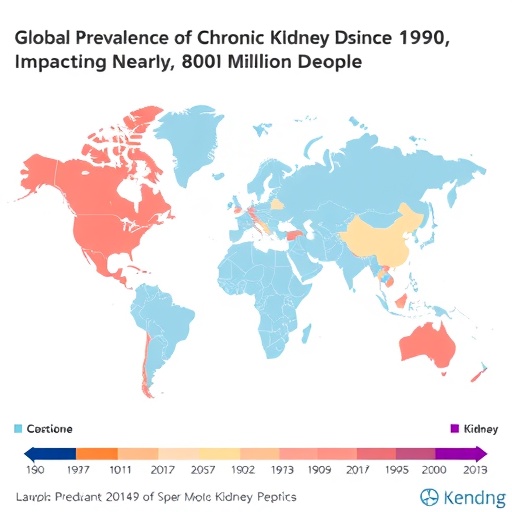
In a groundbreaking study that promises to reshape our understanding of soil ecosystems, researchers have unveiled how subtle shifts in microbial communities can signal impending environmental upheavals. The investigation delves deep into soil microbiomes, revealing that compositional changes among bacterial taxa precede critical transitions in soil functionality driven by pH fluctuations. This discovery opens new avenues for predicting environmental regime shifts, offering a powerful tool for ecological monitoring and management.
The soil microbiome, a complex and dynamic community of microorganisms, governs numerous biogeochemical cycles essential for ecosystem health. However, these communities are highly sensitive to environmental parameters, including pH, moisture, and nutrient availability. Until now, anticipating ecosystem regime shifts—points at which soil microbial functions dramatically change—has remained a challenge. The new research demonstrates that specific bacterial groups, notably members of the Bacillota phylum, increase in abundance just prior to these critical thresholds, effectively serving as early warning indicators.
The study focuses on transitions between distinct functional regimes defined by nutrient cycling dynamics, particularly the utilization of nitrate, a key nitrogen compound controlling soil fertility and greenhouse gas emissions. By monitoring changes in soil pH, the team was able to correlate microbial community composition shifts with the onset of a new regime in nitrate metabolism. They observed that Bacillota populations ramp up at pH values slightly below the transition from what they term Regime II to Regime III, highlighting a predictable microbial response to environmental stress.
.adsslot_piWGSUzxJQ{width:728px !important;height:90px !important;}
@media(max-width:1199px){ .adsslot_piWGSUzxJQ{width:468px !important;height:60px !important;}
}
@media(max-width:767px){ .adsslot_piWGSUzxJQ{width:320px !important;height:50px !important;}
}
ADVERTISEMENT
Importantly, the researchers plotted growth fold changes of Bacillota against other dominant phyla such as Pseudomonadota and Bacteroidota. This comparative analysis revealed a consistent pattern: Bacillota blooms precede transition points defined by metabolic shifts in nitrate utilization. The temporal precedence implies that microbial community data, traditionally used for compositional descriptions, can be harnessed as a predictive tool to forecast functional changes in soil ecosystems.
Beyond observational data, the authors integrated model parameters of community metabolism to dissect the mechanistic underpinnings of how soil microbiomes respond to pH-induced disturbances. This multifaceted approach linked compositional alterations to metabolic function, enabling a systems-level understanding of microbial ecosystem resilience and adaptation. Such insights are critical for predicting how soil communities—and by extension, ecosystem services—will respond to ongoing environmental change.
The implications of this work extend well beyond academic curiosity. Soil health is intrinsically tied to global food security, carbon sequestration, and climate regulation. Functional shifts in the soil microbiome can dramatically alter nutrient cycling and greenhouse gas fluxes, making early detection of these transitions vital for sustainable land management and climate mitigation strategies. By identifying microbial indicators of impending regime changes, this research sets the stage for the development of rapid diagnostic tools for soil ecosystem monitoring.
Another striking feature of this study is the use of pH—a fundamental yet understudied environmental parameter—as a predictor for microbial regime shifts. While the importance of soil pH to microbial ecology is well-known, quantifying its role in triggering functional transitions in microbial communities at a mechanistic level required innovative experimental design and analytical prowess. The researchers’ ability to map bacterial growth dynamics across pH gradients underscores the delicate balance microorganisms maintain with their physicochemical environment.
Furthermore, the identification of Bacillota as sentinel species offers exciting prospects for biomarker discovery. Members of this phylum have diverse metabolic capabilities and are often resilient to environmental stresses, making them ideal candidates to signal impending environmental tipping points. This knowledge could facilitate targeted interventions to mitigate soil degradation or to enhance microbial functions beneficial to agriculture and natural ecosystems.
The methodology employed integrates high-throughput sequencing with dynamic metabolic modeling, representing a state-of-the-art approach in microbial ecology. This coupling allows for not just descriptive, but predictive and mechanistic insights. By bridging the gap between community composition and ecosystem function, the study addresses a long-standing challenge in environmental microbiology: linking “who is there” with “what they are doing” and “what will happen next.”
Moreover, the findings resonate with broader ecological theory concerning regime shifts and tipping points in complex systems. Soil microbiomes, often viewed as black boxes, emerge from this research as intricate networks with identifiable patterns preceding large-scale functional changes. Such predictive frameworks could, in the future, be adapted for monitoring other microbial ecosystems, including aquatic environments, human-associated microbiomes, and biotechnological systems.
The research team also highlights the potential for deploying microbial early warning signals in real-world applications. Whether for assessing soil degradation due to acid rain, agricultural runoff, or climate-driven alterations, microbial indicators could provide rapid feedback to land managers and policymakers. This proactive capability would mark a paradigm shift from reactive to preventive ecological stewardship.
In sum, the study delivers compelling evidence that soil microbial communities are not only dynamic responders to environmental change but also valuable predictors of ecological stability. The elucidation of functional regimes through microbial composition and metabolism paves the way for leveraging microbiomes in environmental diagnostics. As anthropogenic pressures on terrestrial ecosystems intensify, such novel insights are timely and critically needed.
This work stands as a testament to the power of interdisciplinary research, combining microbiology, environmental science, and computational modeling to tackle pressing ecological challenges. It invites future investigations to expand on these findings, exploring other environmental gradients and microbial taxa to build comprehensive models of ecosystem health and resilience. The promise of microbial early warning systems could redefine how we manage, protect, and restore soil ecosystems in the face of rapid global change.
Lee and colleagues’ contribution marks a significant step forward in microbial ecology and environmental science. By focusing on functional regimes and the predictive power of microbial community shifts, they chart a path toward smarter, data-driven approaches to ecosystem monitoring. Amid escalating environmental uncertainty, such innovations could prove instrumental in safeguarding the planet’s vital soil resources for generations to come.
Subject of Research: Soil microbiome responses to environmental change, focusing on pH-induced functional regime shifts and microbial predictors.
Article Title: Functional regimes define soil microbiome response to environmental change.
Article References:
Lee, K.K., Liu, S., Crocker, K. et al. Functional regimes define soil microbiome response to environmental change. Nature (2025). https://doi.org/10.1038/s41586-025-09264-9
Image Credits: AI Generated
Tags: Bacillota phylum bacteriabiogeochemical cycles in ecosystemsearly warning indicators for ecosystemsecological monitoring and managementenvironmental regime shiftsmicrobial community shiftsmicrobial response to environmental changesnutrient cycling in soilsoil fertility and greenhouse gas emissionssoil functionality transitionssoil microbiome dynamicssoil pH fluctuations





